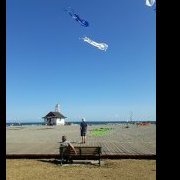‘It Was a Tragic Scene to See the Dead Bodies of Our Brothers and Sisters’
-
Recently Browsing 0 members
- No registered users viewing this page.
-
Topics
-
-
Popular Contributors
-
-
Latest posts...
-
38
Visa options for 4-5 month snowbird stay for winter 2025-2026
A lot depends on just how long I want to stay -- 4 months or 5 months. If only staying 4 months, then 60-day VE + exit to Laos/Vietnam for at least several days + re-enter on another 60-day VE makes the most sense as it avoids the trip to immigration for the 30-day extension as I would still need to exit the country after the 90 days are up. The 30-day extension only makes sense if I need to stay for 5 months. There's not much difference between 4 and 5 months, so I will likely limit my time to 4 months in Thailand and a week or two in another SE Asian country. The other benefit to a second consecutive 60-day VE is that I won't need to buy a separate disposable onward ticket to present on re-entry as I will already have a return ticket to Canada for March. I will have to have a short-dated onward ticket for the first entry, however. And I will hold the hotel reservation and 20K in cash just to be safe. -
2
Where to buy Compounded SEMAGLUTIDE Lyophilized Powder
Thank you for the reply. Is there generic rybelsius available? I was quoted nearly 14,000 baht for a months supply of 14mg name brand rybelsius. -
98
Economy Thailand Rejects 0% Tax Deal with US, Cites Risk to Local Farmers
Hilarious "solutions" by the average geriatric expat panel of social refugees ! In another 2 years or less the USA will be relegated to try hard status as the rest of the world it screwed over moves on and away. Enjoy. -
77
-
19
Economy Duty-Free Giant King Power Closes Shops in Bangkok and Pattaya
Exactly. A bottle of Sangsom cost more at King Power than at the local 7/11 -
13
Hunsum Man
As American use Love for everything and anything, a Scandinavian rearly use the love of it's not 100% true. Some do abuse now more often than before of course, and would say anything to get in to pants of a lady. But on the serious side, I think I never said I love you to my first gf, and my first real love, I think it took longer than a year before one of us said the word. My wife have never said I'm handsome, only when I'm teasing her after someone tells her I am, she say I am, and you know it, but that's not a word she abuse at all.
-
-
Popular in The Pub

.thumb.jpeg.42eea318e3350459f0aaaa5460326bca.jpeg)






Recommended Posts
Create an account or sign in to comment
You need to be a member in order to leave a comment
Create an account
Sign up for a new account in our community. It's easy!
Register a new accountSign in
Already have an account? Sign in here.
Sign In Now